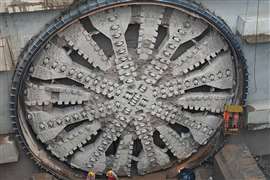China rolls out ‘largest’ diameter shield machine for underwater highway project
08 November 2024
A super-large diameter shield machine named Jianghai made its way off production lines in China enroute to the Haitai Yangtze River Tunnel project for contractor China Railway Construction Heavy Industry Corporation (CRCHI).
 The ‘record breaking’ “Jianghai” shield machine, which CRCHI is using on the Hatai Yangtze River Tunnel project. (Image: CRCHI)
The ‘record breaking’ “Jianghai” shield machine, which CRCHI is using on the Hatai Yangtze River Tunnel project. (Image: CRCHI)
The 16.64m-diameter shield machine (a type of tunnel boring machine or TBM) is believed to be the world’s largest independently-developed unit of its type, and the Haitai Yangtze River Tunnel is designed to be the world’s longest underwater highway once complete.
“This follows the domestic first 16-metre class super-large diameter shield machine Jinghua, as CRCHI surpasses itself and sets a new record,” said CRCHI.
Jianghai is about 145m long and weighs approximately more than 4,500 tonnes.
“Jianghai is named by integrating the two concepts of crossing the Yangtze River and being adjacent to the sea in the Haitai Yangtze River Tunnel project,” said CRCHI. “Its cutter head is painted with blue waves moving forward, symbolising that the TBM will gather strength to dive and traverse the rivers and seas.”
The Haitai Yangtze River Tunnel is located in the Yangtze River estuary area of Jiangsu Province, starting from Haimen District in Nantong in the north and ending in Taicang City in Suzhou in the south. The total length of the project line is 39km, with the cross-river tunnel designed at 11km long.
“Jianghai will complete the ultra-long distance single-headed tunneling underwater in the Yangtze River,” added CRCHI. “The settlement requirement is controlled within 1cm, [meaning] the construction difficulty is great, and the geological exploration coverage in the river is limited, with many uncontrollable unknown areas.”
Details for the Haitai Yangtze River Tunnel project
 The Nanjing Fourth Bridge crosses the Yangtze River in Nanjing, Jiangsu Province, China. (Image: Adobe Stock)
The Nanjing Fourth Bridge crosses the Yangtze River in Nanjing, Jiangsu Province, China. (Image: Adobe Stock)
The tunnel will feature a two-way, six-lane highway with a design speed of 100 km-per-hour. The tunnel section is more than 9km long, with a maximum excavation diameter of 16.64m.
“Along the route, it needs to pass through complex geological belts such as silty clay, silty clay interbedded with silt and fine sand, with a maximum burial depth of about 75m and the highest water pressure reaching 7.5 bars. It features ultra-long distance, ultra-large diameter, ultra-high water pressure, ultra-deep burial, and complex working conditions,” added CRCHI.
The contractor noted the complex and sprawling scheme required advanced research and development (R&D).
“In response to the construction risks and difficulties of the project, the R&D team has made purposed designs on key parts such as the cutter head and the main drive through innovative research. It is equipped with a soft soil cutter head with accessible cutter head and alloy cutters that are large, hard, widely covered, and wear-resistant,” said CRCHI.
It continued, “The main drive is equipped with a telescopic function that can sense the overall force of the cutter head, effectively avoiding abnormal force on the cutter head caused by overload of the main bearing under special circumstances, facilitating cutter change operations, assisting the cutter head to break out, and equipped with a main drive status monitoring system to continuously monitor the operating status of the main drive.
“At the same time, the shield body size and structural thickness are designed according to local conditions, the oil cylinder specifications are increased, the slurry circulation system and grouting system are optimized to enhance the overall performance of the machine, and a smart assembly system for segment connection components is configured to meet the construction requirements.”
Majority completion of the project is expected in 2028.
CONTÁCTESE CON EL EQUIPO






